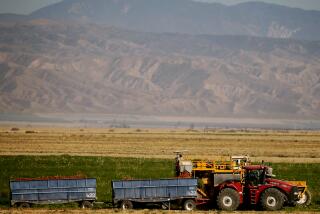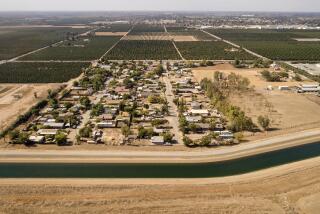With flush aquifer, Coachella Valley golf courses slow to conserve

At brunch on a recent Thursday, Sunny Butler nibbled at an omelet and considered playing a round later that afternoon. Part of the joy of living on the 18th hole of the Citrus Club in the Coachella Valley, Butler said, is the verdant green landscape just beyond the back door.
“We consider it part of our yard,” she said.
And with membership dues and fees of about $1,500 a month — on top of the $30,000 initiation fee — she added, “You sort of feel like you’re paying for the grounds and the greens, so if anybody starts to tamper with that — that’s a problem.”
The Citrus is one of 123 courses in the Coachella Valley, the world-renowned resort destination that spans 45 miles from Palm Springs to Indio. Its golf courses suck up about 37 billion gallons of water annually. While other parts of drought-stricken California pray for rain to keep toilets flushing and salvage crisping crops, water here has been cheap and plentiful, thanks to a massive underground aquifer that allows course owners to soak fairways with enough water to fill about 56,000 Olympic-sized pools each year.
The golf industry has been struggling to remain relevant and profitable for years as younger players shy away and more baby boomers work through retirement. But in recent months, the game’s top officials have identified water as the biggest threat, particularly in California, where it has become more scarce and expensive. Courses across the state have tried to rein in water use in recent years, but Coachella Valley resorts — which account for 14% of the state’s golf courses — have been slow to conserve.
Local officials say the region’s cheap, plentiful water, its economic reliance on golf and residents’ expectations of lush life on the green make it difficult to change water use habits. The hotel, amusement and retail sectors collectively accounted for about 40% of jobs in the valley and 30% of payroll in 2013, according to a recent economic report.
Golf and water leaders acknowledge that the profligate use cannot continue, and they have started meeting regularly to discuss ways to increase conservation without spoiling the scenery that keeps tourism here thriving.
“Change can be hard for people,” said Dean Miller, president of the superintendents’ association that oversees the valley. “[But] if your club isn’t honestly sitting down looking at some long-range planning, I think you may get caught in the end.”
After decades of demand-driven building, the number of golf courses nationwide declined for the first time about a decade ago. When the housing bubble burst around 2007, course superintendents looked hard at the cost of water.
In Southern California, almost all courses now use smart watering systems, said Craig Kessler, director of government affairs for the Southern California Golf Assn. About a quarter — nine of 35 — of courses served by the Los Angeles Department of Water and Power use recycled water. And recently, five golf courses across the city replaced more than 3 million square feet of turf with drought-tolerant landscaping, taking advantage of the department’s rebate program.
There is little evidence of a water problem in the Coachella Valley, though.
The region relies primarily on an underground aquifer so big that when the U.S. Geological Survey tried to measure its size, scientists got to 12 trillion gallons, “and then they stopped counting,” Coachella Valley Water District spokeswoman Heather Engel said.
Water retailers here use the state’s reservoirs to replenish groundwater supply, but not to directly serve customers, so the drought’s impact is mitigated. State law prohibits water agencies from charging more than it costs to produce water, which means prices stay low. The CVWD’s base rate is about $1.12 for 748 gallons of domestic water, compared with $5.06 for the same amount of water from LADWP.
Without a cost incentive to conserve, residents in the district, which supplies water to about two-thirds of the valley, are among the highest per-capita water users in the state. The approximately 202,000 residents used more than 330 gallons of water per person per day during the month of October — more than triple the amount LADWP residents used.
About a third of CVWD’s water goes to urban and domestic use, Engel said. Golf courses use 17%, she said.
During summers in the valley, temperatures regularly rise past 100 degrees, more than tripling evaporation rates and forcing heavier watering to keep courses playable. A single golf course in CVWD boundaries uses an average of about 300 million gallons of water annually — about three times the amount typically used at a coastal course in Southern California and more than double what inland courses consume, officials said.
In an effort to reduce water use, groundskeepers at Sunnylands, the historic Annenberg estate in Rancho Mirage removed 60 of the course’s 180 acres of turf grass and replaced it with a combination of less thirsty tall grass and mulch, said Patrick J. Truchan, director of operations. Officials also decided not to seed grass as heavily in parts of the fairway.
Those efforts put Sunnylands ahead of others in the Coachella Valley. More superintendents might consider turf removal, Miller said, but no rebate exists for golf courses within CVWD, so large-scale replacement hasn’t occurred. Only about 18% of valley courses use recycled water.
The CVWD has asked golf courses to cut water use by 10% between 2010 and 2020. By comparison, courses under LADWP must cut 20% if they want to irrigate whenever they choose.
“This valley does not have a water problem compared to the rest of the state,” Truchan said. “But for us, morally and ethically, [saving water is] the right thing to do. The sad truth is, financially, the motivation is just not there yet.”
A local task force recently finalized funding for a study that will measure the economic impact of golf on the Coachella Valley. In Palm Springs, local experts said, visitors spend 6% of their dollars on golf, or about $270 million a year.
Another complicating factor for golf superintendents, real estate agents say, is that rights to golf courses are often written into property deeds, making alterations difficult.
Superintendents must also consider dues-paying members.
On a Thursday afternoon, a group of women finished their morning round at the PGA West’s Arnold Palmer course. They piled into a golf cart with a Jaguar hood ornament and groused about patches of yellowing Bermuda grass that dotted otherwise immaculate rolling acres of lush greenery.
“The playability is quite different,” said club member Lynne Dozer, 66. “If we have to have the dormant Bermuda to get through this water crisis, fine. But as soon as this ends, I’d like to go back.”
As the drought persists, though, officials in this golf mecca have become increasingly concerned about withdrawing too much from the aquifer.
The CVWD has overdrafted all but five years since 1990, according to officials who have analyzed district data. The rate of annual overdraft is slowing, in part, because water use is decreasing, and a 2014 status report predicted that overdrafting can be eliminated by 2021 if reductions continue.
Water managers started serving more than two dozen courses with canal water, which does not impact the aquifer, and they have plans to provide canal water to seven more. Some newer courses, such as PGA West’s Greg Norman course, were designed for the desert, with narrow strips of fairway and tee boxes surrounded by decomposed granite. CVWD officials say they plan to use part of a state grant to launch a long-awaited turf rebate program for golf courses.
Conserving water now will only help golf in the long run, said Miller, the president of the superintendents’ association. But he has discovered that altering expectations in this idyllic desert paradise isn’t easy.
“Even though we have the water to do what we’re currently doing,” Miller said, “we also realize that that’s not always going to be the case.”
matt.stevens@latimes.com
Twitter: @MattStevensLAT
More to Read
Sign up for Essential California
The most important California stories and recommendations in your inbox every morning.
You may occasionally receive promotional content from the Los Angeles Times.







